Johannes Vermeer: Signatures
Of the 35 generally accepted paintings by Vermeer, 25 bear signatures, which, however, vary greatly in state of conservation and, hence, visibility.
Four signatures that were once reported can no longer be detected,1 and three paintings once bore the signatures of other artists before they were correctly attributed to Vermeer.2 Only three signatures are accompanied by dates.3 One painting4 bears two signatures, one of which is accompanied by a date. Never once did Vermeer accompany a signature with "f[ecit]," a frequent feature that accompanies signatures on a
Vermeer's signatures are located on almost every area of the canvas (the Essential Vermeer catalogue numbers of Vermeer's signed paintings indicate their relative positions on the interactive diagram below). Some signatures float upon a blank area of a white-washed wall or a dark void. Others are positioned deliberately on simple objects such as a foot stool, a picture frame or a rock, without seeking, except in one or two cases, symbolic or physical identity with the underlying object. Nine are inscribed on patches of bare white-washed wall. A few signatures were once so conspicuous that they may have meant to contribute to the aesthetics of the work.
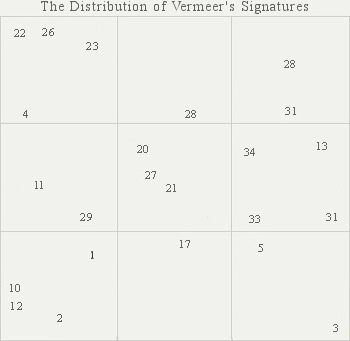
For info about signature → single-click number, then click on title.
Signatures are found on two objects to which letters of the alphabet might naturally belong: the wall map of The Art of Painting and the open letter which cascades over the front edge of the carpet-covered table of Lady Writing a Letter with her Maid. It could be speculated that by placing his signature on the wall map of The Art of Painting just to the right of the standing Clio, the muse of fame, the artist proposed a double symbolic bond: on one hand with himself and his country, the Netherlands, and on the other with everlasting fame. In fact, since classical times it was understood that great artists brought fame not only to themselves but to their native city and country.5 The role artists played in bringing glory to their homeland was given a northern flavor by Karel van Mander in his Het-Schilderboeck (The Book of Painting) of 1604, and, closer to Vermeer, in Dirck van Bleyswijck's Beschryvinge der Stadt Delft (Description of the City of Delft), published in 1667, very near the year in which The Art of Painting was executed.
The dimensions of Vermeer's signatures also varies greatly in both absolute and relative dimensions. Some signatures are so small that they seem to have been intentionally hidden, prompting the spectator to seek them out, while others are too prominent to be ignored (most of the latter type have degraded with time and are barely visible today).6 The color of Vermeer's signatures varies from near black to cool and warm gray. Five are executed with lighter paint over darker background while the remaining twenty are executed with darker paint over a lighter background. Curiously, the two works which feature only monograms are the largest (View of Delft) and one the smallest (Girl with a Red Hat) of his oeuvre.
With respect to the signatures of other Dutch genre painters, those of Vermeer vary considerably in position, relative dimension and, to some degree, form. Such an unusual variability suggests that the concept of the fixing his name to his work was particularly meaningful for Vermeer.
Technique
The signatures of Vermeer's paintings are applied with fluid oil paint and a fine-tipped brush held in the hand steadied on a maulstick a few centimeters above the surface of the canvas, a practice indispensable for creating precise signatures sometimes scarcely more than a centimeter in length. The maulstick also allowed the artist to apply his signature directly into wet paint, if he desired to do so. In any case, the painter must define the variations in thickness of the letters more deliberately than with the scribe's flat-tipped pen, which, differently than the brush, produces such variations automatically if held at the same angle. With a pointed brush the thin lines are created using only its very point, while the thick lines are made by increasing the pressure of the brush so that it will spread out. Some of the thin lines in Vermeer signatures are scarcely more than a hair's width. In those signatures that are well conserved it is possible to observe that the marks are made with precise, decisive strokes. Given their relatively crisp edges most of them seem to have been painted over a dry layer of paint, while a few that are blurry (e.g., A Lady Writing) suggest that they may have been painted directly into wet paint (wet-in-wet).
Morphology
Unfortunately, given that some of Vermeer's surviving paintings no longer bear signatures and that some of those that exist are in a prejudicial state of conservation, it is difficult to track the precise evolution of Vermeer's signatures. Nonetheless, 24 of the 25 surviving signatures—the condition of the signature of the Girl Reading a Letter by an Open Window is too degraded to allow an accurate assessment of its form—can be grouped into four types (in this article; a, b, c and d), which, perhaps, permit some considerations regarding the chronological ordering of the artist's oeuvre, as well as the authenticity of some signatures.
Type a

The body of type a (Diana and her Companions, A Maid Asleep and The Little Street) begins with a left-slanting vertical line whose lower extreme is attached to the left-hand base of the M, thereby forming a V (the V of "Vermeer"). This is preceded by an I (of "Johannes"). A dot stands between the I and the body of the signature. The entwined VM is followed by eer in cursive, which, obviously, completes the artist's name.
Type b

Type b (Christ in the House of Martha and Mary, The Procuress and, in monogram only, View of Delft) is formed by a monogram in capital letters followed by eer in cursive. The monogram is formed by an M whose left-most line inserts itself into the valley of a wide V below. The lower extreme merges with the V's bottom. A dot placed directly above this first line of the M transforms it into a J (of "Johannes"). The type b signatures are executed with relatively quick, rhythmic gestures. A similar signature is present on Saint Praxedis, a presumed early work by Vermeer whose authenticity, however, is strongly debated.
Type c

The letters I and M of the type c monogram are formed according to classical convention, with alternating thin and thick lines that terminate in evident serifs. These letters are referred to as Roman letters. Following the universal convention, the first line of the M is thin, the second thick and so on. The I (of "Johannes") is inserted into the valley of the M. Its lower extreme does not fully merge with its companion M as in type a. Its serifs gently repose on the interior sides of the V creating a small triangle of empty space below it. The converging diagonals of the M double as a V (of "Vermeer"). The monogram is followed by eer in cursive. A flourish issues from the base of the r terminating in a dot, although in a few paintings with type c signatures the flourish is partially or completely invisible, most likely due to an imperfect state of conservation. The letters e and r are in so-called "cursiva humanistica" style formed differently from those which appear on legal documents signed by the artist. The Girl with a Red Hat is signed with only the monogram only of type c signature. After devising type c signature Vermeer used another type of signature in only two paintings.
The perfect symmetry of the type c monogram, as well as the manner in which the missing V is subtly teased out from the M—the "Ver" [from] is less important that the "Meer" ["sea" or" lake"] in Vermeer's name—makes this type particularly appealing to the eye and intellectually satisfying. The lines of the type c monogram are created with a somewhat slower and more controlled hand than those of types a and b. Judging by the more or less accepted chronological order of Vermeer's oeuvre, it would seem that the space between the monogram and the first e is somewhat wider (about the full width of the e) in the earlier paintings with type c signature and generally narrower in the later works (click here to see a complete facsimile set).
With respect to the type c, types a and b signatures may appear less sophisticated in execution and design. In his 1866 three-part article Gazzette de Beaux-Arts about Vermeer, Thoré-Bürger published a facsimile of the signature of the The Milkmaid, which is no longer visible (see facsimile below). If we were to assume Thoré's facsimile to be reasonably accurate, it would constitute evidence of the first use of the type c signature in the artist's oeuvre.
Type d

Type d signature is without a monogram, and it is found on two mature works by Vermeer, The Art of Painting and The Geographer. It is formed by an I., followed by Ver, a dash and Meer. The I, V and M are in Roman capital letters while the e (of Ver) and the eer (of Meer) are in cursive. A flourish issues from the base of the final r, terminating in a dot.
Vermeer's Hand-Written Signature
The signature of Vermeer below is drawn from a legal guarantee for a debt for 250 guilders that the artist's father had contracted, in 1648, from a sea captain, Johan van Santen.

A Few Considerations on the Chronology of Vermeer's Paintings
Types a and b signatures belong to Vermeer's early work, while those of type c, interspersed by two type d signatures, span the rest of the artist's output. If one were to group Vermeer's signed works into two chronologically ordered blocks with the first block consisting of types a and b and the second with types c and d, the type b monogram of View of Delft would suggest that this work was executed somewhat earlier than most critics suppose. The free, "splotchy" application of paint (the so-called rouw [rough] technique) of View of Delft shares nothing with the careful modeling and even application of paint of The Girl with a Wine Glass, which bears a type c signature and is almost always dated before the former picture. Thus, The Girl with a Wine Glass (and likely the unsigned Girl Interrupted in her Music) signals a change in both signature type and technique with respect to the earlier works.
Roman Letters of the Monogram and Remaining Cursive Letters
 "M"
"M"Divina Proportione
Luca Pacioli (illustrated by Leonardo da Vinci)
published in Venice, 1509
From the Renaissance onward the use of Roman capital letters in artist's signature is not rare. Pieter de Hooch, one of Vermeer's closest colleagues, signed his paintings with three Roman letters in sequence: P.D.H. In the Netherlands Roman letters were widely used for inscriptions in books, and maps and they are clearly visible on the maps and the inscription the virginal lid in The Music Lesson of Vermeer's interiors, evidencing that the artist was familiar with this script.
In ancient times, Roman letters were more often used for inscriptions cut with a chisel than letters made with a brush. The variation of thin and thick lines as well as terminal serifs give Roman letters their typical legibility, energy, balance and stateliness. No alphabet has been more successful.
The original thickening and thinning of the lines of the Roman capitals may owe to the fact that "early Latin scribes held their stiff-nibbed reed pens almost directly upright and at right angles to the writing surface, so that a down stroke from left to right and slanted at an angle of about forty-five degrees would bring the nib across the surface broadwise, resulting in the widest line possible to the pen. On the other hand, a stroke drawn at right angles to this, the pen being still held upright, would be made with the thin edge of the nib, and would result in the narrowest possible line."7 The forms of these letters were then imitated by stone cutters. An alternative theory is that stone cutters first painted the letters on the stone with a flat-ended brush, which, like the flat-tipped brush, creates the thin and thick lines automatically if held at the same angle. Edward M. Catich8 advanced that serifs originated from the way scribes wrote with flat-tipped pens. "The top serif originated in a slight movement of the pen to get the ink flowing. The bottom serif comes from a flick of the pen at the end of a stroke to finish it off neatly. In formal types of writing or large-scale painting or carving, the leading and finishing strokes were balanced with a similar stroke on the other side of the main stroke."9 An alternative theory is that serifs were devised to neaten the ends of lines as they were chiseled into stone.
Since no formula has ever been found to reduce the original Roman letters to mathematical scheme, the excellence of these letters is attributed to the sense of proportion and design of the workmen who made them.10
In Vermeer's time, there was no lack of models for well-proportioned Roman letters, many of which were produced during the revival of classical culture by Italian scribes and humanist scholars of the early 15th century. The Alphabetum Romanum (1463) by Felice Feliciano was the first book to demonstrate how to create Roman capital letters based on the geometrical subdivision of a square. In 1509, Luca Pacioli published Divina Proportione ("Divine Proportions") in which he discussed mathematical proportions and their applications to geometry, perspective, architecture and the Roman letter alphabet. Pacioli's alphabet, based on the work of Leonardo da Vinci, met a widespread demand for those who wanted to know how the construct "perfect" Roman letters.
Pacioli's volume had a great impact on his contemporaries and was immediately followed by Sigismondo Fanti's Theorica et practica ("Theory and Practice") in 1514 and Francesco Torniello's Opera del modo de fare le littere maiuscole antique ("Work on the Way to Make Ancient Majuscule Letters") in 1517. While there is no evidence that Vermeer knew any of these texts we might imagine that Pacioli's description of his own volume was well suited to the Dutch artist's temperament: "A work necessary for all the clear-sighted and inquiring human minds, in which everyone who loves to study philosophy, perspective, painting, sculpture, architecture, music and other mathematical disciplines will find a very delicate, subtle and admirable teaching and will delight in diverse questions touching on a very secret science."
Textualis form, commonly known as Gotisch or "Gothic script," was used for general publications from the fifteenth century on, although it gradually became restricted to official documents and religious publications during the seventeenth century.In the Netherlands, Roman letters were used for special purposes during the time of Vermeer, such as inscriptions and book headings. This suggests that, unlike modern individuals who are unconscious of scripts derived Roman letters owing to their ubiquitous presence in printed matter, Vermeer's contemporaries would have noted the use of Roman letters in his signatures and attached some significance to this choice. It is likely that the use of Roman letters suggests the artist's desire to link his art to classical values.
The cursive e's and r's of Vermeer's signatures are derived from a unique style of formal writing developed in the Renaissance, known as "cursiva humanistica." Cursiva humanistica is a slanted and rapidly written letter that had evolved from the upright humanistic minuscule, which itself was developed to reconcile a stylistic mismatch between the Roman capital letters and the small Carolingian letter. Cursiva humanistica became the model for cursive or italic typefaces. As books printed with early roman types forced humanistic minuscule out of use, cursiva humanistica gained favor as a manuscript hand for the purpose of writing.
Anomalies
The exact form and proportion of Vermeer's signatures vary somewhat within each type. For example, the e's is at times more slanted, at times more upright. The length of the r flourish varies in length and the first e of the earlier type c signatures is more distant from the V than of the later pictures. The M of the type c monogram usually fits into a square but in some pictures it is noticeably elongated, or widened. Nonetheless, although the minuscule scale of Vermeer's signatures such variations can be expected, the signatures of three pictures present anomalies that are so significant that they may be considered extraneous to Vermeer's manner of signing his paintings.
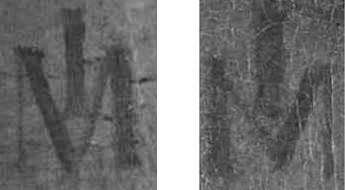 The monograms of Vermeer's A Lady Seated at a Virginals (left) and The Guitar Player (right) evidence the incorrect sequence of thin and thick lines of the M of The Guitar Player. (Both images have been desaturated and contrasted in order to enhance their visibility.)
The monograms of Vermeer's A Lady Seated at a Virginals (left) and The Guitar Player (right) evidence the incorrect sequence of thin and thick lines of the M of The Guitar Player. (Both images have been desaturated and contrasted in order to enhance their visibility.)1. The Guitar Player
Curiously, the order of the thin and thick lines of the M of the monogram of The Guitar Player is reversed with respect to those of all other type c signatures (see comparison left). Moreover, both the serifs and the sequence of thick and thin lines of Roman letters inscribed on the wall maps of the artist's interior scenes, as well as the lid of the virginal in The Music Lesson (see image left below), are correctly articulated. Thus, for an artist very familiar with Roman letters and so extraordinarily sensitive to proportion and detail, such an oversight seems highly improbable. Nor does there seem to exist a plausible artistic motive why the switch between thin and thick lines might have been voluntary. For anyone more than superficially familiar with Roman letters, such an error is tantamount to misspelling a word.
Since some art historians believe that The Guitar Player was still in possession of the artist's wife, Catharina Bolnes, upon his death, it may not have yet been signed. It can be hypothesized that either Catharina or the person who eventually acquired the painting had it signed by someone who had an authentic type c Vermeer signature before him but who was neither sufficiently attentive nor cultured to comprehend that the order of thin and thick lines is not arbitrary but fixed by centuries-old convention. It is also possible that the original signature was reinforced at an unknown date, which often happened with paintings that are centuries old.

The Music Lesson (detail)
Johannes Vermeer
c. 1662–1665
Oil on canvas, 73.3 x 64.5 cm.
The Royal Collection, The Windsor Castle
In fact, pictures that remained unfinished after an artist's death were routinely spruced up in order to increase the likelihood of sale. The addition of a signature to an unsigned work of an important painter does not necessarily suppose malicious intent, but simply to authenticate a known fact. John Michael Montias proposed that The Girl with a Flute, another late work by Vermeer, was begun by Vermeer and finished after his death by an inferior painter, perhaps Jan Coelenbier, who bought paintings from Vermeer's widow soon after his death."11 With various Vermeers on hand, Coelenbier would have found the task of copying one of Vermeer's signature relatively simple.
2. A Lady Writing a Letter with her Maid
Differently from the conventional sequence of thin and thick lines of the letters of other type c monograms, except for that of The Guitar Player, the lines of the monogram of A Lady Writing a Letter with her Maid appear relatively even in width, although somewhat wobbly. Moreover, the I is fully connected with the valley of the M and the whole signature is strongly angled (the angle follows the slant of the sheet of paper on which it is inscribed). None of these characteristics are not found in any of Vermeer's surviving type c signatures, although the cursive eer and flourish are in line with other signatures of this type. As in the case of The Guitar Player, some art historians believe that A Lady Writing a Letter with her Maid was in possession of Vermeer's wife upon the death of the artist (for the most informed analysis of this topic see: Adriaan Waiboer, Vermeer and The Masters of Genre Painting exhibition catalogue, pp. 286-287, under no. 5, note 5.15 Thus, as with The Guitar Player, it is not out of the question that the signature of A Lady Writing a Letter with her Maid was applied by someone not entirely familiar with Vermeer's type c signatures after the canvas left the artist's studio. However, judging by a high-resolution image it seems not to have been reworked because the application of paint app rears relatively thin and the brushwork particularly fresh, as if there was nothing concealed under it.
3. The Geographer
The Geographer, presents not one but two signatures, one of which is accompanied by a date. The catalogue of Dutch baroque paintings of Frankfurt Städel Museum (2010) states that on the basis of microscopic analysis of the museum's conservators both signatures are well integrated into the paint layer and can be considered original. Nonetheless, the occurrence of two signatures on the same painting begs some sort of explanation. Moreover, there is no mention of them in the catalogues of the sales through which the picture has passed. Thoré-Bürger, who was particularly attentive to signatures as a means of authentication, did not note the dated signature. In the case one doubts the authenticity of both signatures, given that Vermeer's Astronomer is signed on the wooden cupboard behind the seated scientist and is considered a pendant to The Geographer, the signature of The Geographer on an identical cupboard would appear to be most likely the best candidate for the original signature.
Vermeer's Signatures 1.0: A New Set of Facsimiles
The first, and hitherto only, set of black and white facsimiles of Vermeer's signatures first appeared in 1920 (P. Johansen, "Jan Vermeer de Delft: A propos de l'ordre chronolgique de ses tableaux"(Oud Holland, vol. 40, 1922), 25.). Despite their utility, the set is incomplete and presents such inaccuracies that they do not en courage stylistic comparisons. Click here to download the original set.
The facsimiles used on this web study were produced by the author, Jonathan Janson, of the Essential Vermeer website. They are based, except in a few cases, on tracings from high-resolution digital images kindly furnished by those institutions13 that house the artist's signed works. Consequentially, despite every effort, the quality of the facsimiles is not perfectly uniform. Moreover, even with good high-resolution images some signatures are difficult to trace because the signatures themselves are not in good condition,14 while the tonal value of others is so near to that of the background that they can be barely distinguished.16
As should be obvious, the relative dimensions of the facsimile of this page and of the downloadable set are not preserved. Instead, using the M' of each signature as a guide, the signatures are reproduced roughly equal in dimension in order to evidence their morphological characteristics.
Any suggestion that might improve the accuracy of the facsimiles is warmly welcomed.
Click here to download a JPG file of the complete set the facsimiles (1800 x 2590 pixels).


- Signed lower left, on a large, light gray rock between the dog's profile and a thistle: VMeer (VM in ligature ); type a; gray over off-white; strongly abraded. Neither the quality of the contours nor the movements of the brush are discernable.
- Thoré-Bürger published a facsimile of a signature similar to the type a signature that he had found on Interior of a Beguinage, a painting which he had erroneously attributed to Vermeer.
-
In 1876, Victor de Stuers, one the most influential Dutch politicians in the arts of the period, bought for the Mauritshuis the Diana and her Companions, which at the time was attributed to Nicolaes Maes. In 1885, de Stuers carefully examined the signature and realized that the letters NM were created from what he believed were remains of an underlying signature that included the letters IVM. De Stuers concluded that the painting was by Johannes Vermeer of Delft. A photo-engraving of the forged signature was published by Franz Seraph Hanfstaengl (1804–1877) in 1890.
-
In 1892, Abraham Bredius, at the time director of the Mauritshuis, and his Deputy Director, Cornelis Hofstede de Groot, undertook further examination of the monogram. Bredius secured the Dutch government's permission to subject the signature on the Diana to an "experiment with mineral spirits." After applying mineral spirits to the signature, the restorer, Z. L. van den Berg, determined that the false Maes monogram NM had been made from the remnants of a signature that read JVMeer. However, this discovery did not convince Bredius that the painting was by the Delft master because in his opinion it "clearly showed the traces of having been painted under Italian influence." He concluded that it was not a work of Vermeer of Delft, but of Jan Vermeer of Utrecht. The result of this research was published in the 1895 catalogue raisonné of the Mauritshuis, which included a facsimile drawing of the signature (see image below), and again in 1935. In the Mauritshuis catalogue of 1898, the Diana was still attributed to the Utrecht Vermeer, although the catalogue text stated that the painting had previously been attributed to "Maes and by some to the Delft Vermeer." With the discovery of Christ in the House of Martha and Mary, which was clearly signed IVMeer, Bredius traveled to London in 1901 to examine the picture together with Willem Martin, the new deputy director of the Mauritshuis. Both became convinced that on the basis of color and signatures the newly found Christ in the House of Martha and Mary, the Diana and her Companions and The Procuress in Dresden were secure works of the young Vermeer.

- in 1950 P. T. A. Swillens wrote* that "we remember a conversation we once had with Dr. Hofstede de Groot on the Diana. The learned scholar who as already stated did not wish to tie this picture to Vermeer's oeuvre, told us with regard to the signature that it was unclear and that in his opinion the first letter was not a J, as declared by the Mauritshuis catalogue, but should be read as a P or an R. A few small dots would easily form one of these letters. Those dots, however, have not been reproduced in the catalogue. The signature would thus be R. or P. Meer. Since no artist of the name Vermeer or Van der Meer is known, whose initials are P. or R., research in this direction could not proceed. It should be noted that at that time little if anything was known of Vermeer's father. We now know that his name was Reinier Vos and that he was called "alias Van der Meer or Vermeer". It is not too risky to interpret the signature, as read by Dr. Hofstede de Groot, as Reinier Vermeer or Reinier Vos-Vermeer or as Reinier Vos-Meer." The facsimile reproduced in Swillens' monograph is illustrated below.

- A drawing made by Carol Pottasch during the 1999-2000 restoration indicates serifs on the base of the M. Neither the J nor the serifs are visible today.
*P. T. A Swillens, Johannes Vermeer, Painter of Delft 1632-1675 ( Utrecht: Spectrum, 1950)

Christ in the House of Martha and Mary
c. 1654–1656Oil on canvas, 160 x 142 cm.
National Gallery of Scotland, Edinburgh

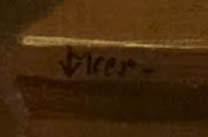
- Signed lower left, on the bench: JVMeer (JV interlaced); type b; dark brown over medium brown. The contours are sharp and the movements of the brush are distinctly discernable.
- Christ in the House of Mary and Martha surfaced for the first time around 1880. In 1901, a cleaning undertaken by Forbes & Paterson, the London dealers who owned the painting, revealed the signature IVMeer. In the same year Abraham Bredius, at that time the director of the Mauritshuis, visited London to inspect the picture and became convinced that both the Diana and her Companions of the Mauritshuis and Christ in the House of Martha and Mary were secure works by the young painter.

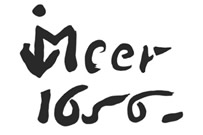
- Signed and dated lower right-hand corner: IVMeer, below 1656 (IVM interlaced); type b; dark gray over medium brown. The contours are crisp and the movements of the brush are distinctly discernable.
- Thoré-Bürger published a facsimile of the signature (see image below) on page 312 of a three-part article ("Van der Meer de Delft," Gazzette des Beaux-Arts, Oct. 1, Nov. 1, Dec. 1, 1866) as cat. no.1, correctly identifying it with Vermeer of Delft. It had previously been attributed to Jan Vermeer of Utrecht. Thoré wrote, "This large picture in the Dresden museum, with four life-size figures and bearing, beneath a full signature, the date 1656 (the first that we know on his works), is absolutely Rembrandtesque, in composition, in character, in drawing and in colour .... Ah! what a masterpiece! and one that loses nothing by being hung immediately above a masterpiece by Rembrandt, the famous picture in which he shows himself seated and laughing, with his young wife Saskia on his knee and holding aloft a long glass full of wine. This date of 1656 is also significant, it must be added, because Van der Meer never made another picture with life-sized figures; at least, we know of no other that is absolutely authentic. For myself, I hold that this Courtesan [The Procuress] in the Dresden museum was painted in Amsterdam, close to Rembrandt."



- Signed on wall, left, above the figure's head: I·VMeer (VM in monogram); type a; dark gray over medium-gray; perhaps altered. Unlike the type a signature of The Little Street, there is no sign of serifs on this signature's capital letters.
- During an autoradiographic examination of the painting at the Metropolitan Museum of Art, the sixth autoradiograph gave some evidence that the signature may have been altered. According to the conservators, the form of the "original signature corresponds to one found on Vermeer's Diana and her Companions, a painting of about 1654–1656. That which can be seen on the painting now is similar to those of later works, such as The Little Street. It is possible that after substantial reworking the painting, Vermeer signed it again in somewhat altered form. However, this cannot be proven. Microscopic examination, in fact, shows that the I and the V were retouched later. Whether this constitutes simply a strengthening of letters already there but clearly fading, as are the eer, or tampering with the signature by someone who knew Vermeer's later paintings, remains unclear." *
* Maryan Wynn Ainsworth et al., Art and Autoradiography: Insights into the Genesis of Paintings by Rembrandt, Van Dyck, and Vermeer ( Metropolitan Museum of Art, New York, 1982), 26.

Girl Reading a Letter by an Open Window
c. 1657–1659Oil on canvas, 83 x 64.5 cm.
Gemäldegalerie Alte Meister, Dresden
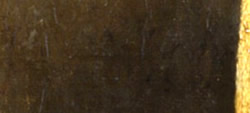
- Signed lower right, on the wall to the right of the woman's skirt: JMeer (fragmentary); dark gray over a lighter gray; barely visible.
- After a visit to the Gemäldegalerie Alte Meister, Dresden in 1859, Thoré-Bürger wrote that he was certain that the painting was by Vermeer and assured that the picture should be signed. Julius Hübner, one the gallery's conservators, later wrote to Thoré, "Nous avons trouvé des traces visibles du mot Meer dans le fond." (We found visible traces of the word 'Meer' on the background).
- P. Johansen published* a facsimile of the signature in 1922 (see image below).
.
* P. Johansen, "Jan Vermeer de Delft: A propos de l'ordre chronolgique de ses tableaux" (Oud Holland, vol. 40, 1922), 25.

- Unsigned
- The painting once bore a forged signature of Pieter de Hooch. *
* See: R. C. Witte, One Hundred Masterpieces of Painting, London, 1910, p. 133.

- Unsigned
- Thoré-Bürger published a facsimile of the signature in a three-part article ("Van der Meer de Delft," Gazzette des Beaux-Arts, Oct. 1, Nov. 1, Dec. 1, 1866) as cat. no 25, with the comment, "La signature est à peu près:"
- The art historian Thomas Bodkin reported that the painting was signed J. V. MEER.*
- Most likely based on Thoré-Bürger's writing, Philip Hale reported, that the painting was signed JVMeer " (JM in ligature).**
- In the first bulletin of 1908 of the Koninklijke Nederlandse Oudheidkundige Bond (The Royal Netherlands Antiquarian Federation) the acquisition of The Milkmaid by the Rijksmuseum was announced, stating that the painting seems to bear no signature (p. 6). The records of the restorations in 1950 and 1983 also make no mention a signature.
* Thomas Bodkin, The Paintings of Jan Vermeer ( New York: Oxford University Press, 1904), 13.
** Philip L. Hale, Vermeer ( Boston and New York, 1913 and 1937), 176.

Girl Interrupted in her Music
c. 1658–1661Oil on canvas, 39.3 x 44.4 cm.
Frick Collection, New York
- Unsigned
- There is no record of any signature on this painting.

The Glass of Wine
c. 1658–1661Oil on canvas, 65 x 77 cm.
Staatliche Museen Preußischer Kulturbesitz, Gemäldegalerie, Berlin
- Unsigned
- There is no record of any signature on this painting.



- Signed lower left, below the window on a patch of white-washed wall : i·VMeer (VM in ligature); type a; approximately 3.8 cm. wide; dark brown over off-white. Although strongly abraded, the signature presents rudimentary serifs on its capital letters.
- The signature registered in infrared examination suggesting that it may contain (some) carbon black.
- Thoré-Bürger published a facsimile of the signature in a three-part article ("Van der Meer de Delft," Gazzette des Beaux-Arts, Oct. 1, Nov. 1, Dec. 1, 1866) (see image below).

The Girl with a Wine Glass
c. 1659–1662Oil on canvas, 78 x 67 cm.
Herzog Anton Ulrich-Museum, Brunswick
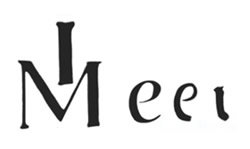

- Signed center left, on lower left window pane: IVMeer (IVM in ligature); type c; light gray over dark brown.



- Signed lower left, on the boat: IVM ( IVM in ligature); type b; approximately .5 cm. wide; white over deep red. Early facsimiles show a dot to the right of the signature, which is no longer visible. The contours are sharp and the application of paint fresh, but the brushtrokes appear unevenly fractured.
- Thoré-Bürger published a facsimile of the signature in a three-part article ("Van der Meer de Delft," Gazzette des Beaux-Arts, Oct. 1, Nov. 1, Dec. 1, 1866) (see image below).

The Music Lesson
c. 1662–1664Oil on canvas, 73.3 x 64.5 cm.
The Royal Collection, The Windsor Castle


- Signed center right, on the black picture frame above the white jug: IVMeer (IVM in ligature); type c; approximately 1.5 cm.wide; medium bluish gray (with natural ultramarine?) over black. The contours are relatively blurred.
- Despite its renown, The Music Lesson was not always attributed to Vermeer. One of the most distinguished art collectors of the eighteenth century, Joseph Smith (1675— 1770), the British Consul in Venice, believed that the signature IVMeer on the picture was as that of Frans van Mieris, one Vermeer's most famous competitors. In an inventory of paintings sold to King George lll of England in 1762, Smith called the work: "Frans van Mieris ... A Woman playing on a Spinet in presence of a Man seems to be her father."
- The M of the latin motto inscribed on the open lid of the virginals is very near the same dimension as that of the M of the artist's signature.


- Unsigned
- In the first American monograph dedicated to Vermeer Philip Hale wrote that the painting was "signed on the wall beneath the table: '"Meer.'" *
- Perhaps, following Hale's catalogue entry, Thomas Bodkin also claimed that the painting was "signed, MEER." **
- Wilem van der Watering* reported that the painting is "vaguely signed on the wall, below the table." ***
- Although t here is no sign of a legible signature on the painting,a black and white photograph taken in 1963 reveals what may be the vestiges of a type c signature inscribed on the background wall underneath the tablecloth. The monogram barely discernable and the eer fainter still.
* Philip L. Hale, Vermeer ( Boston and New York, 1913 and 1937), 114.
** Thomas Bodkin, The Paintings of Jan Vermeer (New York: Oxford University Press, 1904), 13.
** Albert Blankert, Vermeer ( New York, Woodstock, London. 2007) 171.

Young Woman with a Water Pitcher
c. 1662–1665Oil on canvas, 45.7 x 40.6 cm.
Metropolitan Museum of Art, New York
- Unsigned
- There is no record of any signature on this painting.

- Unsigned
- In order to support the authenticity of the painting, Thoré-Bürger mentioned an almost effaced signature and cites its traditional attribution in earlier sale catalogues.*
* Frances Suzman-Jowell, "Vermeer and Thoré-Bürger: Recoveries of Reputation," in Vermeer Studies, edited by Ivan Gaskell and Michiel Jonker (New Haven and London: Yale University Press), 55.

Woman with a Pearl Necklace
c. 1662–1665Oil on canvas, 55 x 45 cm.
Staatliche Museen Preußischer Kulturbesitz, Gemäldegalerie, Berlin

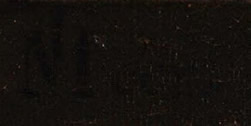
- Signed center, on the forward side of the tabletop: IVMeer (IVM in ligature); type c, approximately 2.5 cm. wide, dark gray of medium-dark brown. The contours are slightly blurred.
- Thoré-Bürger published a facsimile of the signature in a three-part article ("Van der Meer de Delft," Gazzette des Beaux-Arts, Oct. 1, Nov. 1, Dec. 1, 1866) as cat. no.33, and noted, "Signé sur la table:"
- Thoré also made a quick sketch of the painting which shows the location of the signature. (Special thanks to Frances Suzman-Jowell for permission to publish this image.)
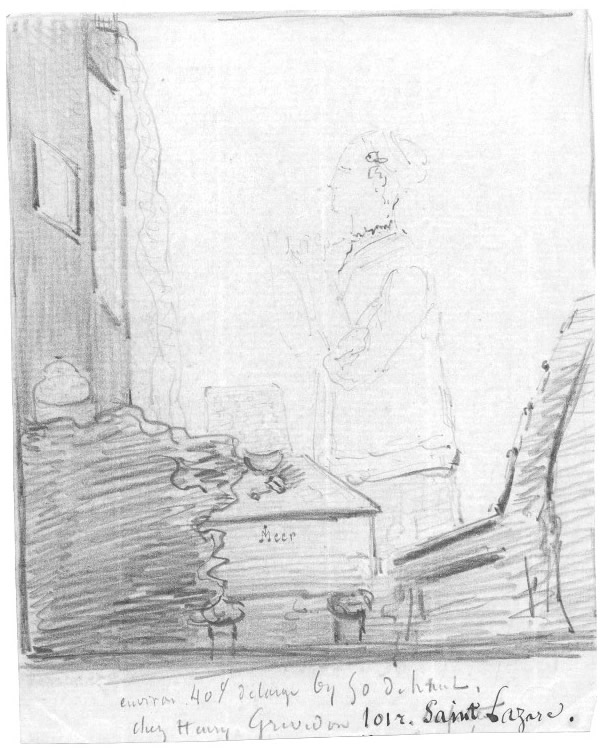 All rights reserved © Frances Suzman-Jowell
All rights reserved © Frances Suzman-Jowell

Woman Holding a Balance
c. 1662–1665Oil on canvas, 42.5 x 38 cm.
National Gallery of Art, Washington D.C.
- Unsigned
- Following the death of the King of Bavaria, Maximilian I, who had resided at Nymphenburg castle near Munich since 1799, the Woman Holding a Balance was sold in an auction at Munich on December 5, 1826. In the sale catalogue the traditionally attribution to Vermeer had been changed to Gabriel Metsu, apparently confirmed by a monogram reading GM. The reliability of this signature was not absolutely accepted, as the catalogue reported: "van der Meer according to others."
- A sketch by Thoré-Bürger indicates Vermeer's monogram (IVM in ligature) on the front side of the table, in the same position as that of Woman with a Pearl Necklace. Since Thoré was particularly attentive to signatures as a means of establishing the authorship of Vermeer's paintings, the existence of the monogram on this drawing should be considered a factual record of the now-lost signature. (Special thanks to Frances Suzman-Jowell for permission to publish this image.)
 All rights reserved © Frances Suzman-Jowell
All rights reserved © Frances Suzman-Jowell

- Unsigned
- There is no record of any signature on this painting.



- Signed center left, on frame of the picture on back wall: IVMeer (IVM in ligature); type c; approximately 3 cm. wide;medium-dark gray over slightly darker black. The contours are blurry in comparison to other signatures of the same type and period.



- Signed center, on the map, behind Clio's collar: IVer-Meer followed by date in Roman numeral: type d; light brown over medium gray. The contours are relatively sharp.
- Signed also as Pieter de Hooch. This signature is still present along the lower cross support of the artist's stool, and can be seen with the aid of infra-red reflectograhy. It is not known when the authentic signature was uncovered.
- A recent I.R.R. examination of the painting undertaken by the Kunsthistorisches Museum has revealed that the letters MDLXVI??? (1666-67-68) followed the signature (according to Kunsthistorisches Museum most likely 1668 given the extent of the overpaint). The type of the numerals is consistent with the dates of The Geographer and The Astronomer.
- Thoré-Bürger discovered the signature. He wrote: "Une signature P. de Hooch s'étale sur le barreau du tabouret; quoiqu'elle soit assez ancienne, il n'est pas très difficile de voir qu'elle est fausse, outre que la peinture, cette fois, accuse Vermeer avec la plus grande évidence et sans confusion possible. Aussi, en cherchant bien, trouve-t-on, sur le bord inférieur de la grande carte géographique accrochée au fond de l'atelier, et dans un ton neutre qui se perd parmi les inscriptions et les dessins de la carte, une magnifique signature entière. (A signature P. de Hooch evidences itself of a bar of the stool. Although it is quite old, it is not very difficult to see that it is false, and besides the painting, this time, signals Vermeer in great evidence and without possible confusion. So, on the lower edge of the large map hanging on the background wall of the studio, and in a neutral tone that is lost among the inscriptions and drawings of the map, one finds a magnificent signature in its entirety.)
- Thoré-Bürger published a facsimile of the signature in a three-part article ("Van der Meer de Delft," Gazzette des Beaux-Arts, Oct. 1, Nov. 1, Dec. 1, 1866) (see image below).

- Although speculative, in this most ambitious of all canvases Vermeer may have placed his signature barely to the right side of Clio, the muse of fame, identifying his persona Clio and thereby assuring his own fame.

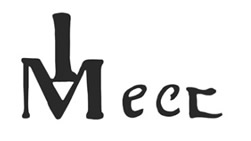

- Signed top left corner: IVMeer (IVM in ligature); type c; approximately 5.7 cm. wide; lighter gray over dark. The form of the signature is barely discernable.
- The signature, perhaps one of Vermeer's largest, is placed in the same position as that of the Study of a Young Woman .

Girl with a Red Hat
c. 1665–1667Oil on panel, 23.2 x 18.1 cm.
National Gallery of Art, Washington, D.C.

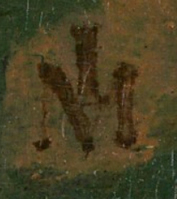
- Signed upper-left center; IVM in ligature; type c monogram only; approximately .5 cm.wide; dark brown over deep ochre. The contours are relatively sharp. Some abrasion.

- Unsigned
- The art historian Thomas Bodkin reported that the painting displayed the "remains of a signature." *
- What seems to be traces of Vermeer's signatures near the top of the shadowed side of the casket disappeared at the touch of the weakest solvent, indicating that they were a later addition. **
- Lawrence Gowing wrote that "the fragment of a signature is said to be visible, though not in typical form." ***
* Thomas Bodkin, The Paintings of Jan Vermeer ( New York: Oxford University Press, 1904), 13.
** See: The Frick Collection: An Illustrated Catalogue, Vol. 1, New York, 1968, 296.
*** Lawrence Gowing, Vermeer,(Berkeley and Los Angeles: University of California Press, 1952, 1970, 1997), 146.

- Unsigned
- There is no record of any signature on this painting.

Study of a Young Woman
c. 1665–1674Oil on canvas, 44.5 x 40 cm.
Metropolitan Museum of Art, New York

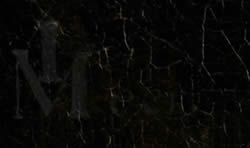
- Signed on upper left-hand corner : IVMeer [IVM in ligature]; type c; approximately 3.5 cm. wide; medium gray of dark gray. The contours of the monogram are crisp, those of the eer cannot be discerned.
- The signature is placed in the same position as that of the Girl with a Pearl Earring.

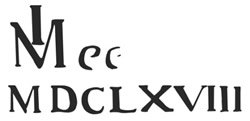

- Signed center, on cabinet: IVMeer / MDCLXVIII (IVM in monogram); type c; signature approximately 2.8 cm. wide;: date approximately 4 cm. wide; date in Roman numerals (1668); dark paint over deep ochre.
- In a print representing this picture by Louis Garreau (1748), reversed, the engraver did not reproduce the signature when it was in the collection of the French art dealer LeBrun in 1784. It has been speculated that it was added to the picture from information on the original frame when LeBrun provided it with a new one.*
- The German art historian Otto Mündler saw the painting at Christie's and sent to Thoré-Bürger a facsimile of the painting's signature. Thoré remarked that the signature was similar to that of The Geographer and that is dated in Roman numerals MDCLXVIII.
* Leonard Slatkes. Vermeer and his Contemporaries ( New York: Abbeville, 1981), 82.

The Geographer
c. 1668–1669Oil on canvas, 53 x 46.6 cm.
Städelsches Kunstinstitut, Frankfurt am Main
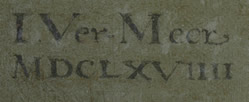
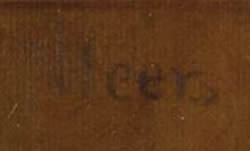


- There are two signatures on The Geographer. One is inscribed on the cupboard behind the standing scientist: IVMeer (IVM in ligature); type c; approximately 2.5 cm. wide; medium gray over a lighter brown. The contours are relatively sharp and the color of the monogram is considerably lightened with respect to the eer. The second signature is inscribed on the background wall to the upper right: I.Ver-Meer with the Roman numerals MDCLXVIIII (1669); type d; appromately 5.8 cm. wide; j dark gray over off-white. The contours are particularly sharp.
- The catalogue of Dutch baroque paintings of Frankfurt Städel Museum (2010) states that on the basis of microscopic analysis of the museum's conservators both signatures are well integrated into the paint layer and can be considered original. *
- Both the dates and signatures have been questioned by art historians because there is no mention of them in the catalogues of the sales through which the picture has passed.* According to Slatkes, "although the signature on this picture is probably not authentic, the date apparently records accurate information that may have been on the original frame." **
- Thoré-Bürger, who was very attentive to signatures, noted the signature on the cupboard but made no mention of the signature and date in Roman numerals on the wall.
- Lawrence Gowing held that the original signature is that on the panel of the cabinet. He e wrote that "twenty-six pictures, by Vermeer or reputed to be, were at the time of his death in the possession of Jan Coelenbier, a landscape painter as well as a dealer, who certainly had palette and brushes to hand. Such an inscription as that on the Frankfurt Geographer appears to have been added simply to authenticate a known fact." ***
- In 2010, Robert Wald wrote, “It would seem plausible, regarding the strong similarities between the inscriptions on both the Frankfurt and the Vienna works, that the inscription of the wall within The Geographer could have been added slightly later (by the artist) based on the style of the lettering from The Art of Painting.” ****
* Pierre Descargues, Vermeer ( Editions d'Art Albert Skira, Geneva, 1966), 133.
** Leonard Slatkes. Vermeer and his Contemporaries ( New York: Abbeville, 1981), 85.
*** Lawrence Gowing, Vermeer,(Berkeley and Los Angeles: University of California Press, 1952, 1970, 1997), 129.
**** Robert Wald, "'The Art of Painting': Observations on Approach and Technique," in Vermeer: Die Malkunst, edited by Sabine Haag, Elke Oberthaler and Sabine Pénot (Kunsthistorisches Museum, Vienna: Residenz, 2010), 319, note 11.


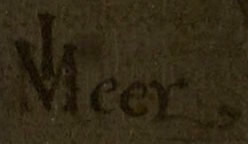
- Signed center left, on the patch of background wall above the clothes basket: IVMeer (IVM in ligature); type c; approximately 2.3 cm. wide; dark gray over lighter gray. The contours are somewhat blurred and the monogram is relatively narrower than those of the same type c..
- The signature registered in infrared examination suggesting that it may contain (some) carbon black. It is painted wet over dry. In some areas the paint used for the signature shows a slight resist pattern (for instance on the inside of the upper part of the second e). The left side of the letter M is slightly lighter as the rest of the signature.*
* Personal communications with Ige Verslype



- Signed upper-left, on the gray wall: IVMeer (IVM in ligature); monogram of type c; approximztely 2 cm. wide; light gray over off-white. The signature is so worn that the first e is barely visible. No flourish appears on the r.
- Thoré-Bürger published a facsimile of the signature in a three-part article ("Van der Meer de Delft," Gazzette des Beaux-Arts, Oct. 1, Nov. 1, Dec. 1, 1866) (see image below). as cat. no.37 with the comment, "Signé en toutes lettres."


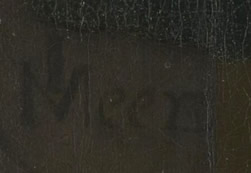
- Signed center right, below the edge of the curtain: IVMeer (IVM in ligature); type c; dark gray over slightly lighter gray. The contours are somewhat blurred although the movement of the brush clearly visible. The baseline of the letters s is tilted slightly..
- Differently from those found on the signatures of Vermeer's mature and late works, the order of the thin and thick lines of the M is unconventionally reversed. For an artist very familiar with the Roman letters and so extraordinarily sensitive to proportion and detail, such an oversight seems highly improbable. Nor does there appear to exist any motive why the switch between thin and thick lines might have been intentional. Since The Guitar Player was probably still in possession of the artist's wife upon his death, it may not have yet been signed. It can be hypothesized that either the artist's wife or the person who eventually acquired the painting had it signed by someone who had an authentic Vermeer signature before him but who was neither sufficiently attentive nor cultured to comprehend that the order of thin and thick lines is not arbitrary but fixed by centuries-old convention.

Lady Writing a Letter with her Maid
c. 1670–1671Oil on canvas, 71.1 x 58.4 cm.
National Gallery of Ireland, Dublin


- Signed center right, on a sheet of paper which hangs over the front of the carpet-covered the table, under the hand of the writing lady: (IVMeer, IVM in ligature); type c; dark gray over lighter gray. The contours are sharp and the movement of the brush is clearly discernable in the letters eer. The baseline of the letters is titled downwards approximately 16 degrees from horizontal.
- Differently from those found on the signatures of Vermeer's mature and late works, the lines of the monogram do not respect the traditional sequence of thin and thick lines of Roman capital letters. Also unusual is the signature's strong clockwise slant and the fact that the I merges completely with the M (see more about these anomolies here).


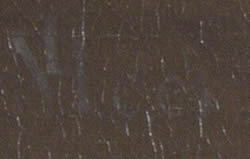
- Signed center left, below the upper edge of the virginal: IVMeer (IVM in ligature); type c; light gray over deep, reddish ochre.



- Signed center right, on a patch of nude wall below the lower edge of the large gilt framed picture-within-a-picture: IVMeer (IVM in ligature); type c; approximately 2.3 cm. wide; dark gray over a medium gray. The contours vary from relatively sharp to slightly blurry.
- A sketch by Thoré-Bürger indicates Vermeer's signature (circled) to the right of the seated musician and below the frame, with the signature reproduced in large scale to the upper left. (Special thanks to Frances Suzman-Jowell for permission to publish this image.)
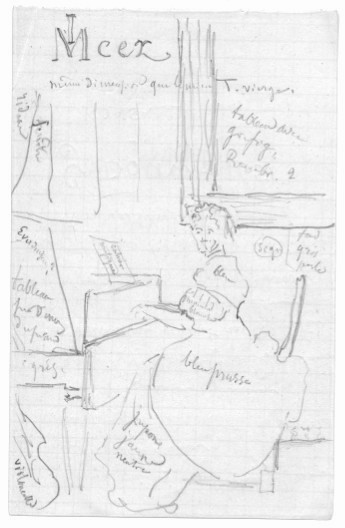 All rights reserved © Frances Suzman-Jowell
All rights reserved © Frances Suzman-Jowell

- Unsigned
- By the end of the 19th century, the Allegory of Faith was in Moscow, in the collection of Dmitrii Tchoukine, the first and only Vermeer to ever be in Russian possession. The painting was attributed to Eglon van der Neer. Tchoukine consigned the work in 1899 to the dealer Wàchtler in Berlin. It had a false signature of Caspar Netscher on the stone which crushes a snake on the floor, in the lower center (Report Mauritshuis 1899, 56 n. I). The art historian Abraham Bredius saw the painting and immediately recognized it as a Vermeer although he did not reveal his discovery to the seller, and bought it a paltry 700 marks (about $167).

Saint Praxedis
(attributed to Johannes Vermeer)1655
Oil on canvas, 101.6 x 82.6 cm.
National Museum of Western Art, Tokyo


- Signed twice. One signature is at the lower left, on a stone: VMeer 1655 (VM in ligature) type b; dark gray on medium ochre; abraded. The second signature is barely visible: perhaps Meer N R[..]o[.]o; light ocher on an ocher earth tone.
- Michael Kitson wrote, "Yet, as is pointed out in the catalogue, the picture bears the signature and date (1655), which are apparently integral with the paint surface, of Jan Vermeer. The catalogue is properly cautious about this, yet I do not see how its implications can be evaded. The form of the signature corresponds exactly to those on Vermeer's early works, particularly the Girl Asleep in the Metropolitan Museum (which means that the originals can be readily compared). The date is one year before that of the Dresden Procuress." *
-
The art historian Arthur K. Wheelock Jr. wrote, "The primary reason that the painting has been associated with Vermeer is that it is signed, not once but twice. One signature, on the edge of a rock in the lower left, reads: Meer 1655. The signature and date are somewhat reinforced, but are part of the paint structure. The second signature in the lower right of the painting reads Meer N R..o.o. Although difficult to decipher because it is painted in light ocher on an ocher earth tone, the signature is integral to the paint structure and has not been reinforced. Egbert Haverkamp- Begemann has suggested that it may have originally read: Meer N(aar) Riposo. Riposo was the name often given to Ficherelli. Vermeer's reasons for signing the painting twice, however, are not known." **
- The art historian Albert Blankert wrote, "The attribution [to Vermeer], however, cannot be sustained. Vermeer's "signature" on this work is irregular and the M does not fit with the following letters. ***
- The conservator Jørgen Wadum wrote, "to my knowledge, rarely does a copyist sign his replica twice. Speaking of signatures, the directly readable signature Meer 1655, lower left, must be regarded as apocryphal. Part of this signature is visible to the naked eye despite the fact that the paint under it is heavily abraded. The knobs of the canvas are even partly visible under the signature, indicating that the paint layer was abraded before the signature was added. In my opinion the signature is not integral to the painting. The inscription Meer N R[..]o[.]o bottom right is, however, so rudimentary that any interpretation would be factitious." ****
- Marten van Bok wrote, "The attribution of Saint Praxedis to Van der Meer is not confirmed by any document. At the beginning of my research the knowledge of Van der Meer's Rotterdam background provided a working hypothesis regarding a second inscription, published in 1986 by Arthur Wheelock, as having been found in the lower right-hand corner of Saint Praxedis. He read Meer N R..O.O. Egbert Haverkamp-Begemann suggested to him that this might stand for 'Meer. N[aar] Riposo,' thus proclaiming the 'sphinx's'' authorship of this copy after Felice Ficherelli, known as Riposo. I could not agree with this reading, however. Nowhere in seventeenth-century Dutch painting will you find such an inscription on a copied painting.
An alternative reading, I assumed, could be 'Meer. Natus Rotterodamensis.' It seemed an attractive hypothesis at first, but in the course of my research I had to abandon it on documentary grounds, even before I had seen the painting itself and found no readable inscription at all. Jorgen Wadum's discovery that the other inscription, reading Meer 1655. (lower left), was most probably added at a later date leaves us with no grounds whatever for studying that Italian painting in the light of Van der Meer's oeuvre, nor in that of Johannes Vermeer." *****
* Michael Kitson, "Florentine Baroque Art in New York" (The Burlington Magazine, Vol. 111, No. 795, Jun., 1969), 409-410.
** Arthur K. Wheelock Jr., "St. Praxedis": New Light on the Early Career of Vermeer " ( Reviewed work: Source: Artibus et Historiae, Vol. 7, No. 14, 1986), 71-89.
*** Albert Blankert, Vermeer ( New York, Woodstock, London. 2007) 172, note 5.
**** Jørgen Wadum, �Contours of Vermeer," in Vermeer Studies ( New York and New Haven,1998), 219.
***** Marten van Bok, "Not to Be Confused with the Sphinx of Delft: The Utrecht Painter Johannes van der Meer (Schipluiden 1630-1695/1697 Vreeswijk)," in Vermeer Studies, (New York and New Haven, 1998), 75.

A Young Woman Seated at the Virginals
(attributed to Johannes Vermeer)c. 1670
Oil on canvas, 25.2 x 20 cm.
Leiden Collection, New York
- Unsigned
- There is no record of any signature on this painting.
Artist's Signatures in the Netherlands
drawn from Chapter 1 of:
Rembrandt, Harmenszoon Van Rijn. A Corpus of Rembrandt Paintings IV: Self Portraits, edited by J. Bruyn, Ernst van de Wetering, New York: Springer, 2005.
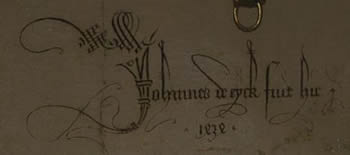
Portrait of Giovanni(?) Arnolfini and his Wife
(detail of signature and date)
Jan van Eyck
1434
Oil on oak, 82.2 x 60 cm.
National Gallery, London
The incidence and significance of signatures of seventeenth-century works of art has received little attention by art historians, and there is very little contemporary literature which discusses them. Various modern art historians hold that given the close cooperative workshop relationship between a master, assistants and apprentices, signatures may have been less important that there are today, fixated as we are, with authenticity. It is not clear in many cases if a signature was meant to indicate that a work had been done entirely by the hand of the master. However, various period sources suggest that their contemporaries were keen on knowing by whom a work had been made.
Early paintings could be marked by the personal mark or stamp of the artisan or of his workshop as well as the hallmark of the guild or city council in order to guarantee a certain level or quality and prevent fraud. By the second half of the sixteenth century, Northern Netherlandish painters began to sign their works in full. Although full signatures gradually became more and more common, monograms did not disappear. Many artists continued to apply monograms although painters affixed signatures that closely resembled their written signatures. Some painters, however, only rarely signed their works. Before the 1600s, Italian painters often signed their works in full followed by a "P" or "pinxit" (Latin for painted). In Southern Netherlands some painters used "pingebat" although the term "fecit" (Latin for made) was increasingly used. Seventeenth-century Dutch paintings with signatures were almost always followed by "f[ecit]." Given the low artisanal level of the overwhelming majority of Dutch paintings churned out at low cost to satisfy the thirst of an ever-growing art buying public, the great part of Dutch paintings are not signed. However, most ambitious painters, who invariably belonged to the guilds, signed their works in order to distinguish their works from those of their less illustrious colleagues. Rembrandt seems to have signed almost all of his works. Some Dutch painters hid their signatures while some placed them so that they could not be overlooked. Many painters had variant signatures. The earliest documentation of falsely applied signatures can be pin-pointed to the last quarter of the seventeenth century. Forged signatures and signatures applied to overcleaned signatures occur from the eighteenth century onwards.
- The Lute Player, The Milkmaid, Woman Holding a Balance and Woman in Blue Reading a Letter
- The Art of Painting, Diana and her Companions and Young Woman Holding a Water Pitcher
- The Procuress, The Art of Painting and The Geographer
- This concept was a subtheme in Giorgio Vasari's influential Lives of the Artists.
- Originally, I and J were different shapes for the same letter.
- The Geographer
- Girl with a Pearl Earring, Study of a Young Woman and The Lacemaker
- Frank Chouteau Brown, Letters and Lettering: A Treatise With 200 Examples, originally published by Perry & Elliott Co., Boston, 2007 <https://www.gutenberg.org/files/20590/20590-h/20590-h.htm>
- Edward M. Catich, Origin of the Serif: Brush Writing & Roman Letters, St. Ambrose University, Davenport (Iowa), 1991
- Karl Young, "The Roman Alphabet in its Original Context," http://www.thing.net/~grist/ld/TextBackHome/Roman.htm: originally appeared in Open Letter, Sixth Series, No. 7, 1987
- ibid.
- John Michael Montias,. Vermeer and His Milieu: A Web of Social History
, Princeton: Princeton University Press, 1989.
- National Gallery of Scotland (Edinberg) Gemäldegalerie Alte Meister (Dresden), Metropolitan Museum of Art (New York), Rijksmuseum (Amsterdam), Staatliche Museen Preußischer Kulturbesitz, Gemäldegalerie (Berlin), National Gallery of Art (Washington D.C.) Kunsthistorisches Museum (Vienna), Städelsches Kunstinstitut (Frankfurt) and The Kenwood House, Iveagh Bequest (London), National Gallery of Ireland (Dublin)
- Diana and her Companions, A Maid Asleep, Girl Reading a Letter by an Open Window, Girl with a Pearl Earring and The Lacemaker
- Adriaan Waiboer, Vermeer and the Masters of Genre Painting: Inspiration and Rivalry, New Haven and London: Yale Universtiy Press, 2017, 286-287, under no. 5, note 5.
- A Lady Writing and Woman with a Pearl Necklace


